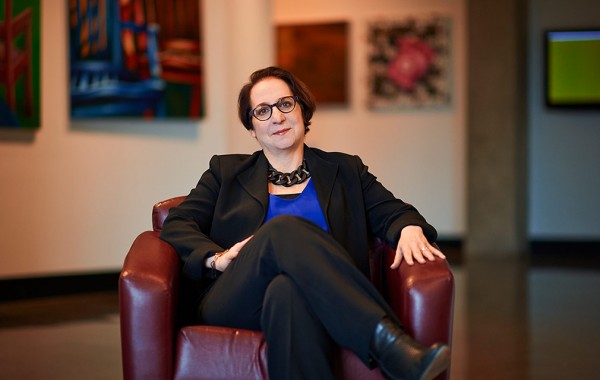Lori Gross ’75
Colgate alumni of all career paths know well the value of their liberal arts educations. Lori Gross ’75 goes a step further: she’s a key voice in advancing arts-related initiatives and facilitating dialogue on arts and culture policy nationally and internationally. The associate provost for arts and culture at Harvard, she works with institutions across the university, including the art museums, American Repertory Theater, Arnold Arboretum, Nieman Foundation for Journalism, Office for the Arts, Mahindra Humanities Center, and Harvard University Press. In April, she brought the conversation to Colgate — in a panel discussion on the arts and humanities in higher education, career advice sessions for students, and through sharing her experience with the Scene as well.
Art in the classroom. Harvard has a project that brings arts-making into traditionally non–arts-making classes. For instance, in an Italian language course, students might do a project about design. We have an opportunity to impact students who might not normally take arts classes. People have been energized by taking photographs, writing a play, and understanding the creative process by doing rather than studying.
All that jazz. Over a period of three years, I worked with musician Wynton Marsalis to bring a series of lecture-performances to the campus. He played and spoke about the history of jazz, relating [it] to the world. Through encounters with students, he could engage in discussions about arts and education or about jazz. He talked to the public service students about work in New Orleans. It energized the campus to be engaged with someone of his stature and his passion.
Journey after Colgate. When I was studying for my degree in art history at Cleveland Case Western, I was simultaneously employed at the Cleveland Museum of Art. Working in museums was my passion from the beginning. I understand the world through objects — objects as storytellers. I believe in museums as being catalysts for collaboration, for understanding, creating safe places for interesting dialogue and discussion.
Over the course of my career, I worked in the Akron Art Museum, the Canadian Centre for Architecture, and Daniel Wolf Gallery in New York, and did freelance cultural projects for museums in Madrid.
For 12 years, I was the founding director for a project called the Museum Loan Network. It was about sharing collections throughout the country — tapping into the concept of some museums having so much in storage and not utilizing it, and other museums not having what they needed to connect to their audience as a community. After that, I was at MIT as director of arts initiatives.
The power of art. Touring around Europe with a friend, the first time I saw Michelangelo’s Night sculpture, it was unbelievably powerful. I saw it again about a week ago. You establish special relationships with [pieces of art]; they refer to different times in your life and they bring those moments back.
Whether you’re watching theater or going to a movie or seeing Night, it gets you in your gut. You think about what that meant for somebody to be carving that hundreds of years ago, and how that face relates exactly to somebody whom you see walking down the street. [Art] embodies all of that in one moment.
— Interview by Marilyn Hernandez-Stopp ’14, Photo by Andrew Daddio







